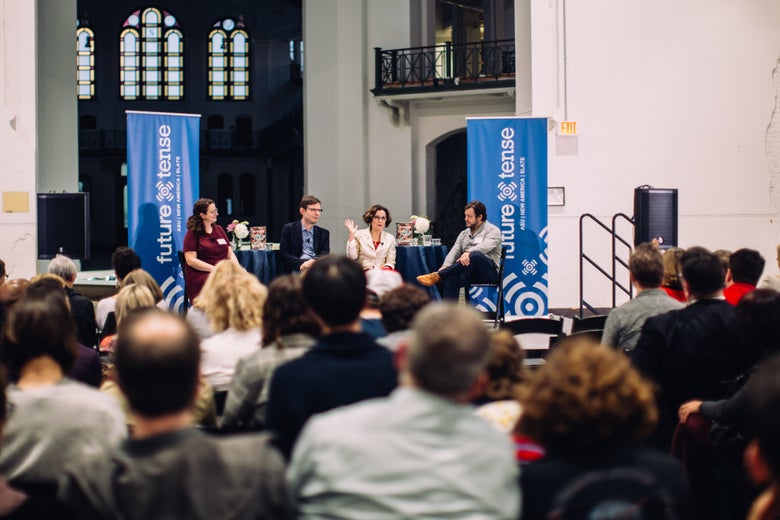
Torie Bosch, Lee Konstantinou, France Córdova, and Ari Lubet
Farrah Skeiky/Smithsonian
For France Córdova, the head of the National Science Foundation, the journey to a career in scientific leadership began with a stack of Philip K. Dick novels. She’s not alone in identifying science fiction as the inspiration to her decision to go into science. At the Oct. 22 event “Can We Imagine Our Way to a Better Future?” Future Tense—a partnership of Slate, New America, and Arizona State University—brought together sci-fi creators as well as leaders in science to celebrate the release of Future Tense Fiction: Stories of Tomorrow and discuss how creative work can inspire the future.
The jewel-like Arts and Industries building, opened in 1881, is the second-oldest building on the National Mall and once hosted almost all of the Smithsonian collections. It displayed the technological marvels of the 1876 Centennial exposition and has been the home for some of the most marvelous examples of imagination. While it has been closed for nearly 12 years, the building is coming back to life with a new focus: the future.
Like the sprawling Arts and Industries building, science fiction has a long and illustrious history, but needs renovation. Dystopian stories crowd the genre, making it difficult to picture the future beyond a ravaged environment, widespread corporate surveillance, and automation taking all of our jobs. During the first conversation of the event, ASU President Michael Crow called for sci-fi writers to supply big ideas for the next generation of scientists, instead of pessimism. (It’s a call he has made before.)
But in another of the event’s three conversations, sci-fi author and associate professor Lee Konstantinou, whose story “Burned-Over Territory” was included in Future Tense Fiction, said that he “understands the bias towards dystopia” for storytellers, but believes that examining ordinary human conflicts in future worlds can be just as interesting. The future in Konstantinou’s “Burned-Over Territory” is no utopia, but fiction allowed him to consider the consequences and benefits of universal basic income without taking a side in the debate.
As moderator Torie Bosch pushed for alternatives to dystopian depictions of the future, there was a noticeable division between storyteller panelists who saw the entertainment value of dark futures, such as Konstantinou and 3 Arts Entertainment’s Ari Lubet, and science leaders whose careers were inspired by imaginative science fiction. For a young ASU President Michael Crow, the writings of Isaac Asimov and watching 2001: A Space Odyssey ignited a career in science education.
Ellen Stofan, director of the Smithsonian Air and Space Museum, believes that science fiction can bring back the joy of scientific inquiry that can be “memorized out” in schools. Acknowledging the long history of fiction inspiring invention, Stofan mentioned how watching the lightsaber practice droid in Star Wars led MIT professor David Miller to challenge his students to build their own … and eventually bring them onto the International Space Station.
In her opening remarks to the event, Smithsonian Arts and Industries Director Rachel Goslins emphasized that interdisciplinary cooperation gets easier the more it is practiced. Fostering interdisciplinary collaboration between the artistic and scientific communities is essential to generate the ideas, solutions, and political will to meet great challenges. The challenge is to find opportunities to grow these relationships.
There’s no better example for arts-science collaboration than science fiction movies.
When Bosch pressed Córdova on whether it is important for science fiction movies to be as accurate as possible, Córdova sighed and said, “it definitely takes me out of it.” Stofan took it a step further, name-checking Oscar-winning Gravity and the storm that sets off the plot in The Martian as gratingly inaccurate. While the release of every science fiction movie has the potential to be met with a takedown from Neil deGrasse Tyson, the silver screen has offered an opportunity for scientists to bring their knowledge to blockbuster audiences. Take Interstellar: Nobel laureate Kip Thorne worked with director Christopher Nolan as the science director for the film. In Future Tense Fiction, many of the authors worked with science and technology specialists, and the stories are always met with an expert response essay.
At a moment where the world is reckoning with existential questions like climate change, Stofan argued that we need “moonshot thinking” from the arts community to inspire big ideas and creative solutions. While humans are notoriously bad at thinking about the future, imagining our future selves can encourage us to make better long-term decisions. The future is not a set destination that we are passively hurtling toward—it’s what we make of it, and the stories we imagine lead the way.
Future Tense is a partnership of Slate, New America, and Arizona State University that examines emerging technologies, public policy, and society.
from Slate Magazine https://ift.tt/328zI2Q
via IFTTT
沒有留言:
張貼留言